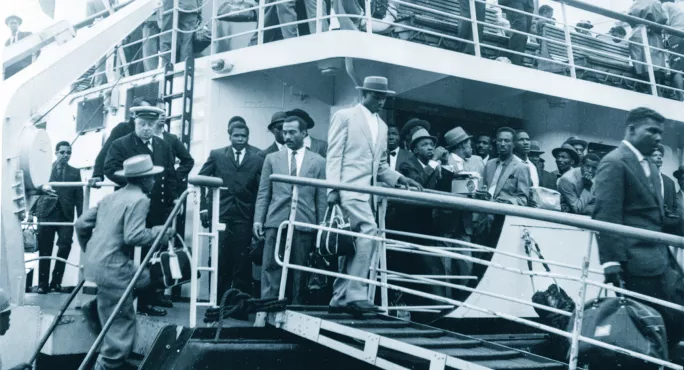
- Home
- Teaching & Learning
- General
- Black History Month: 4 moments to share with your class
Black History Month: 4 moments to share with your class

“I have a dream,” declared Martin Luther King Jr, speaking on the steps of the Lincoln Memorial on 28 August, 1963. “It is a dream deeply rooted in the American dream.”
Like all the great teachable junctures in history, it is a moment rooted in the context of time and place but which speaks to something greater. It is a snapshot that can be used to give us insight into one of the great and tragic narratives of lived human experience. For this reason, the words spoken on that day will be heard and read in classrooms up and down this country as we enter Black History Month.
Children will empathise with the challenges Ruby Bridges faced as she walked into William Frantz Elementary School in New Orleans and marvel at her bravery. They will learn about the collective power exercised during the Montgomery bus boycott and the recalcitrant courage of Rosa Parks. They will read the works of Maya Angelou, encounter the heroism of Harriet Tubman and spend October following the twists and turns of the American civil rights movement.
More on Black History Month:
- We’re celebrating Black History Month all year round
- Why we must teach more black British writers in school
- How to include more people of colour in your curriculum
These undoubtedly important and powerful topics can be used to promote the knowledge and understanding at the heart of the aims of Black History Month but if we’re not very careful, they might also suggest something more problematic: that discrimination is foreign, that racism is peculiar to a particular time and place, and that black history happened somewhere else.
Black History Month: Focusing on black British history
It is important that we counter this by spending some time this October discussing the complex and fascinating black history we have closer to home. Here are four moments from black British history to introduce your classes to.
William Cuffay
If you’re looking for a life story to study this Black History Month, William Cuffay could be just the person. The son of a slave, Cuffay achieved some success as a tailor before becoming heavily involved in leading the 19th-century Chartist movement. Arrested as a spy and charged with treason, he was exiled to live out his remaining years in Tasmania, where he continued his work as a radical political activist. As well as being a great figure to talk about in the context of the industrial revolution, Cuffay’s work towards universal suffrage and freedom of speech makes his story a fascinating one to consider in relation to British values.
Mary Prince
Mary Prince began her life as a slave in Bermuda and ended it as one of Britain’s most notable abolitionists. She worked with Thomas Pringle and the anti-slavery society, who were so affected by her stories of what life as slave was really like that they persuaded her to write what would become the first autobiography of a black woman ever published in Britain. The book’s authentic and powerful account of a brutal life in enforced servitude shocked many out of inaction. If you’re studying autobiography, there are few out there as historically significant as The History of Mary Prince.
Windrush
The story of HMT Empire Windrush has become more familiar to us all over the past few years. It is a story of people who grew up being told they were British, hearing of Britain’s need to rebuild itself following the Second World War. Following the encouragement of the 1948 Nationality Act, they picked up their British passports and boarded the Windrush and ships like it, only to find themselves arriving in a distinctly hostile environment. It’s the individual human stories that best allow us to access history like this and if you’re looking to do some drama, some first-person writing or even a video diary, there are plenty of well-documented figures to choose from, many of whose experiences are a great way into discussing immigration today.
If you’re hoping to make your Black History Month more LGBT inclusive, Stonewall provides lesson plans and resources to explore the story of Ivor Cummings, the openly and proudly gay man (at a time when this was still illegal) of Sierra Leonean descent who worked as a civil servant and spent years finding homes and jobs for the Windrush passengers.
Notting Hill Carnival
Black History Month is a time to celebrate diversity and promote unity. If you’re looking for a way to bring some West Indian food, culture and music into your classroom, why not explore the origins of the Notting Hill Carnival? The story begins with Claudia Jones and her London Caribbean Carnival, which set out to use dancing and partying to bring people together and heal the social wounds left by the racially charged Notting Hill riots.
Thomas Kent is a deputy headteacher in Southend-on-Sea
You need a Tes subscription to read this article
Subscribe now to read this article and get other subscriber-only content:
- Unlimited access to all Tes magazine content
- Exclusive subscriber-only stories
- Award-winning email newsletters
- Unlimited access to all Tes magazine content
- Exclusive subscriber-only stories
- Award-winning email newsletters
You need a subscription to read this article
Subscribe now to read this article and get other subscriber-only content, including:
- Unlimited access to all Tes magazine content
- Exclusive subscriber-only stories
- Award-winning email newsletters
- Unlimited access to all Tes magazine content
- Exclusive subscriber-only stories
- Award-winning email newsletters
topics in this article




